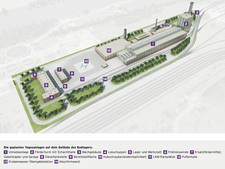Konrad has passed the repository stress test
On 11 March 2011, the earthquake near the Japanese coast and the resulting flooding caused by a tsunami have led to serious damage at the Fukushima Daiichi nuclear power plant. As a result, a nuclear disaster occurred. Based on a stress test, facilities and installations for spent fuel element and radioactive waste management in Germany were now checked in terms of safety in case of a disaster. The future Konrad repository has passed the stress test.
Stress test for nuclear waste management facilities and installations
As a result of the events, the federal government decided to apply the findings from the reactor accident in Japan and to subject the nuclear installations in Germany - in particular the nuclear power plants - to a stress test. However, interim storage facilities and repositories were checked, too.
The Federal Environment Ministry commissioned the Nuclear Waste Management Commission (ESK) in June 2011 with the development of corresponding investigation plans for installations for the treatment, interim storage and disposal of spent fuel elements, heat-generating and all other types of radioactive waste that are currently in operation or under construction. Such an installation is the Konrad repository, an abandoned iron-ore mine located in the city of Salzgitter, which is currently under construction.
Konrad repository under stress test
In 2013, the ESK subjected the Konrad repository to a stress test, in which the part of the future Konrad repository that is located above the surface was considered for reasons of radioactive material being handled here (reloading hall, buffer area). The storage area of the future Konrad repository located above the surface only serves as a buffer and is correspondingly limited.
For the stress test the same criteria were taken as for the interim storage facilities for low-level and intermediate-level radioactive waste. Furthermore it was checked whether the intervention reference level for evacuation in case of a disaster could be reached.

![]() Surface facilities at Konrad Shaft 2
Surface facilities at Konrad Shaft 2
Control of waste before disposal
A key component of the safety concept for the Konrad repository is the quality control of the waste’s packaging in a way that is suitable for disposal (conditioning). In the framework of this quality assurance (waste package quality control) it is checked whether the waste has been packed in accordance with the waste acceptance requirements applicable to Konrad. Procedures are applied that have been checked and released by the BfS. The waste is already conditioned before it is delivered to Konrad, i.e. before the waste packages can even be transported to the repository.
Furthermore, the waste is transported exclusively in officially licensed containers that are safe under radiation protection aspects. These containers have been constructed in such a manner that man and environment are not exposed to impermissible radiation levels, even in the event of an accident. Once they have arrived at the repository, the radiation intensity of all waste containers is measured in the reloading hall (above the surface) as an initial control.
Statement of the ESK
In its statement, the ESK comes to the conclusion that the vital point of the stress test for the future Konrad repository is that all radioactive waste has already been conditioned in a way that is suitable for disposal. It states that the intervention level for evacuation in the vicinity of Konrad cannot be exceeded, since the waste is already conditioned before it reaches the repository.
Background: Konrad Repository
The Lower Saxon Environment Ministry granted the plan-approval decision for the future Konrad repository in 2002. In Germany, Konrad is the first repository for radioactive waste with negligible heat generation that has been licensed according to Atomic Energy Act. The waste will be delivered and disposed of in concrete, cast-iron or steel containers. Upon delivery, all waste must have been packed according to the Konrad waste acceptance requirements (conditioned).
State of 2014.05.16

